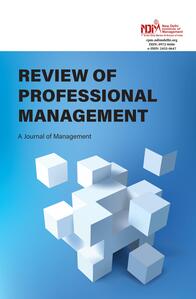
1 School of Management Studies, University of Hyderabad, Gachibowli, Telangana, India
Creative Commons Non Commercial CC BY-NC: This article is distributed under the terms of the Creative Commons Attribution-NonCommercial 4.0 License (http://www.creativecommons.org/licenses/by-nc/4.0/) which permits non-Commercial use, reproduction and distribution of the work without further permission provided the original work is attributed.
The Kumars of Salmora village in the south-eastern part of Majuli, Assam, India, are an example of a family managed business of handcrafting river clay pots. Salmora became the Kumhar village as a result of clay, which became the primary reason for the settlement of potters in the area. The hand-beaten pottery is a cottage industry of Majuli and has been passed down through generations. Currently, the policy restrictions and the dying art form have made people think about how to sustain the handicraft, their livelihoods woven around this art form, and continue their passion/skill in the given challenging situation. This makes it interesting to adopt the case research method to examine the struggle of small businesses to sustain their livelihoods, on the one hand, and the limited alternative sources of livelihood, on the other hand, thus making the survival and sustenance of the family business a challenge, where pottery was their family business for generations. The case discussion revolves around the problems, concerns and causes for the deterioration of the art forms and highlights the issues and challenges. It contributes to the resources in the emerging family business management literature and also the family businesses to strategise in similar contexts.
Family business, pottery, Northeast India, sustainable, livelihoods, traditional art forms
Introduction
‘Pottery was one of the oldest human inventions that had been around since before the Neolithic period with objects dating as far back as 29,000 BC’ (Duary, 2008). The origin of pottery in India could be traced back to the much earlier Mesolithic age. Pottery, like any other archaeological discovery, was a tangible artefact that shed light on past culture/civilisation’s socio-cultural, religious and economic aspects. It was a crucial source for reconstructing prehistory when written records were unavailable and even during historical times, the importance did not diminish.
This successful art style improved with technology throughout the Indus Valley Civilisation. The pottery industry in India was promoted as a major cottage industry as well as on modern lines in both small and large pottery businesses in recent years. The pottery business in India employs a large number of people from rural and urban areas and improves their standard of living. Furthermore, this business contributed significantly to India’s total gross domestic product as well as foreign revenue. The Indian pottery industry bravely crossed several obstacles and emerged as a proud winner. Over the years, no state-of-the-art technical support has been applied to this lucrative industry in India. Moreover, this industry has not made progress in meeting the demands of the current market. Also, the products made from village pottery were sold only to a limited part of society which called for a reassessment of India’s red clay pottery industry.
India was known for its rich culture, which includes many art forms like other handicrafts, crafts and the art of shaping and baking clay articles such as pottery. Unlike other precious materials, pottery was produced and used by common people. It provided an understanding of the way of life and was in demand for storage and other purposes. Ancient pottery aroused the curiosity of scholars and was therefore, considered one of the most important materials used by archaeologists as an indicator to measure the passage of time, determine cultural similarities or evaluate the scope and sociopolitical context of craft production. According to archaeologists, ‘Majuli’s pottery industry was a “missing link” between the Mohenjodaro and Harappan civilizations when the pottery industry flourished’ (Rahman, 2015).
In the far Northeastern region of India, surrounded by the Brahmaputra River nestled in the beautiful island of Majuli, lived a community of potters. Since the sixteenth century, these potters had been the protagonists of Assam’s cultural legacy and heritage. This famed tourist destination in Assam was an oasis of tranquillity, separated from the clamour of the contemporary world. Covered in lush greenery, this slice of paradise thrived on agriculture, pottery and making boats. Pottery was not only a means of earning their livelihoods but also a vital element of their identity that was deeply rooted in their ancestor’s rich cultural tradition. The advancement of modern technology and the changing customer preference had resulted in a decrease in demand for traditional handicrafts making them struggle for their livelihood. The potters of Majuli were struggling to earn their livelihood through pottery. The potters faced a conundrum in balancing their age-old traditions with the need to adapt to changing market dynamics. They were rapidly becoming irrelevant in the contemporary market system, and their struggle to maintain their tradition while remaining relevant was an ongoing challenge. A large area of the land was washed away due to environmental changes; the amount of damage and land loss caused by the land’s erratic nature via flash floods and soil erosion was putting a strain on the population’s ability to adapt and provide for themselves in those trying times. The potters of Majuli were facing an irregular supply of raw materials, a lack of working capital, the use of outdated tools, lack of technology, quality improvement, a lack of a good marketing base, along with management problems. Natural disasters wreaked havoc on those who lived closest to the Brahmaputra’s banks, and the damage was not limited to farmers but also to the potters who relied on the clay as the raw material was found on the banks of the river. This called for a classic case for unveiling the resilience of the Majuli potters in sustaining their family business.
The potters’ community spread over Assam’s districts of Kamrup, Goalpara, Nalbari and Tinsukia as well as a few other districts of Assam. Despite the lack of historical evidence, many historians agreed that the craft was introduced during the reign of the Ahom kings. Majuli island was well known for its unique mud soil, which had the appearance of a mineral resource. This soil was known as ‘Kumar Mati’ in the local dialect. The name was derived from the fact that a specific community’s people gave the name Kumar and were closely associated with the soil, so clay was known as ‘Kumar Mati’. Salmora became the ‘Kumhar village’ as a result of the clay, which became the primary reason for the settlement of potters in this area. Typically, pottery manufacturing sites had a gender-based labour division system that was flexible in the community where both genders could work together at certain stages of production. The process of collecting the clay was done by a group of men from the locality when they set the pre- and post-production stages. The collected clay was then distributed among the household, and from here the process was taken over by the women.
Women of the Salmora region of Majuli practised the traditional form of pottery using gooey clay, sculpting clay by hand without using the wheel. Once the pots were made, they were sundried. The final process of making pots was baking the pots, which was mostly done by men in a mud structure furnace and it was shared among the household. This ancient form of hand-beaten pottery was a notable cottage industry of Majuli and had been passed down through generations (Dewani, 2016). It was entirely based on handcrafted traditional products. It was only preserved in three villages of Majuli: Barboka, Kamjan Elengi and Besamora of Salmora.
The Family Enterprise
Family enterprises were a major form of business organisation, accounting for an estimated 60%–98% of all businesses in different regions of the world. Most small businesses were family owned and played a crucial role in the socio-economic structure of societies and countries all over the world. The efficient operation and succession of a family-owned enterprise were vital to the health of the national economy.
India’s pottery industry was categorised as a small-scale industry. The potters of Salmora village made a living majorly from three seasonal occupations– pottery, agriculture and boat making. The majority of families depended on pottery for their living. Each family operated and managed the craft in their own free time. It was an art form in which every member of the family participated as a labourer, designer and organiser. Since agriculture and boatmaking were seasonal in nature and were dependent on the vagaries of nature, pottery had been the only preoccupation and vocation for the livelihood of the families in the village. However, restrictions had been put on the extraction of clay in the name of soil erosion, which made the potters of Salmora think about their livelihood and future, in the context of the government policy on one side and the dying art, on the other side. This made it interesting to adopt the case research method to examine the fears associated with the potter’s community and their livelihood, where pottery was their family business for generations.
It was a traditional form of family-based cottage industry and was practised by successive generations of community members. The art of pottery-making the Kumar way was a family endeavour. The entire family was involved, with men and women of all ages and genders playing their parts to perfection. To give their pottery a genuine, earthy feel, the family proposes using the old-fashioned techniques of firing it in an open pit. It was based on the traditional handmade product in which the potter’s wheel was not used. Clay was beaten by hand to give the form of utensils. There were 26 varieties of pottery items manufactured such as Mola, Nadia, Choru, Pati Kalah, Becha lkalah, Chaki and so on (Table 1).
Table 1. The Varieties of Pottery Items.
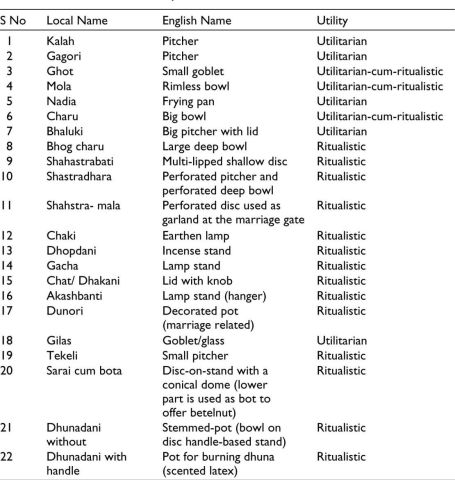
The Demographics
Case research was followed to collect data from a sample of 50 families dependent on pottery-making as their preoccupation and livelihood. Data related to their demographics like age, sex, family income and educational level along with their enterprise data relating to the age of the enterprise and the number of employees. The demographic data revealed that the family business is predominantly female-led, with 35% females and 15% males in the family running the business. Two or more families also came together to run the business, which shows the collaborative and community approach to business (Figure 1).
Figure 1. Gender.
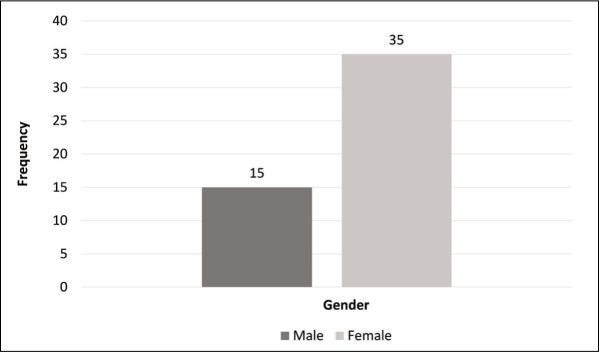
In terms of age, the majority of them were 26 years of age and above, indicating the aversion of youth towards the family business and lack of succession planning (Figure 2).
Figure 2. Age Group.

The annual income of the family was below `10,000 (133.19 USD), which according to them was much below the cost of living required to take care of the basic needs of the family (Figure 3). This highlights the financial challenges faced by the enterprise.
Figure 3. Annual Income.
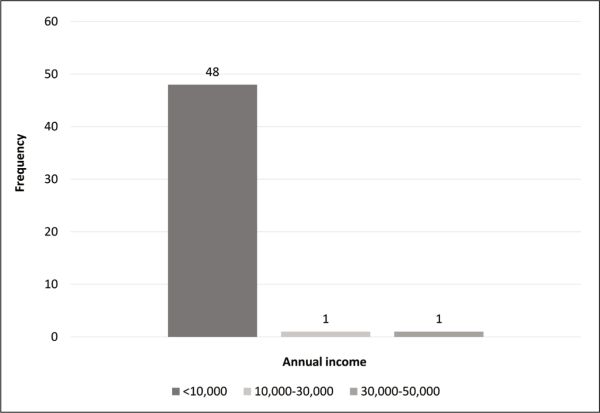
The majority (48%) of the family firms had been operating for more than 25 years. It showed that pottery-making had been their source of income for generations, and it was heartening to note that the art which survived over the years was on the verge of collapse, thus disturbing the family business (Figure 4). This demonstrates the resilience and longevity of this traditional business.
Potters, on the whole, were uneducated, where 14% of them were illiterate and 30% finished primary school and 56% finished secondary school. Educated people were hesitant to work in the pottery industry because of the opportunities that were available in the outside world (Figure 5).
Figure 4. Age of the Enterprise.
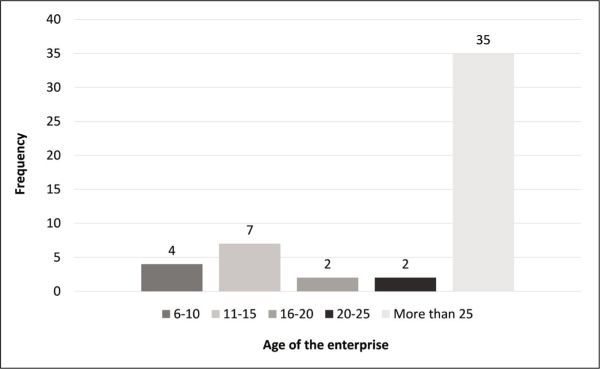
Figure 5. Educational Level.
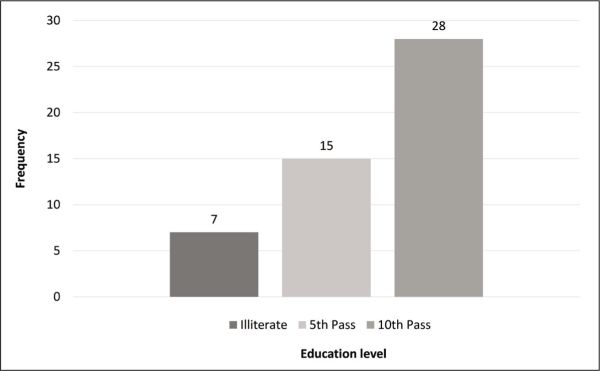
Figure 6 showed that 92% of the business was operated by the family on their own with no employees. Six per cent had less than 5 employees and 2% had 5–50 employees (Figure 6).
Figure 6. Number of Employees
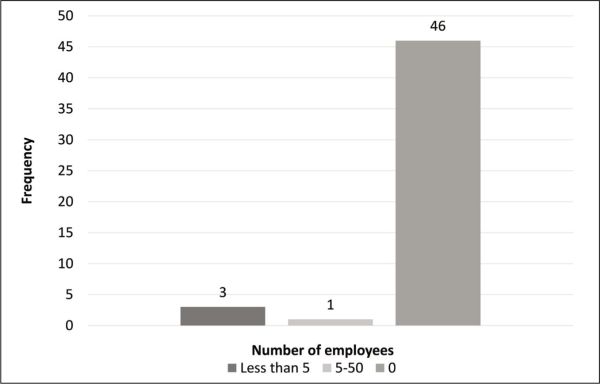
Potters Who Exemplify the Business Art
Since pottery was one of the oldest crafts, many had come and gone over the years, and only a handful remain; hence, it was necessary to recognise the pottery producer who had set themselves apart from the rest. For example, the Prairie fire pottery run by the potter Tama Smith and her husband Jerry made and sold pottery with beautiful, abstract glazed influenced by the landscape of North Dakota. Every summer, millions of travellers passed by on their way to and from the rocky mountains, seeing their pottery billboards and stopping by to buy pots. Collectors and pottery enthusiasts prize Tama’s work for its vibrant and complex colour. These glazed colours were created from scratch using the original recipe. Tama employed a number of manufacturing methods, which included wheel throwing, hand building, extruding and pressing. Various ladles and small squirt bottles were used to apply the glaze. She primarily worked with stoneware clay.
Mr Shiho spent his entire life in the tiny town of Shigaraki, Japan. His early career was marked by years of struggle from being a lawyer to a salesman to being a master in pottery, his life was interesting. Due to his devotion to natural materials (digging clay from his backyard, utilising the traditional Korean kick wheel and burning with just wood for 10 days straight), he was forced to face years of conflict. Shiho San got lucky when he sold tea bowls from the trunk of his automobile to a generous and powerful Buddhist monk. Within a few years, Tokyo skyscraper galleries were vying for his work. Over the years, his work has graced the most prestigious galleries in Tokyo.
Another success story was the Hamada pottery. Tomoo Hamada was the third-generation potter in Mashiko, Japan, and the grandson of a renowned potter Shijo Hamada, a Japanese national living treasure. Hamada pottery helped to establish Mashiko pottery, and now 350-plus pottery studios attracted visitors to spring and fall pottery festivals. Each festival attracted about 500k people to Mashiko to buy pottery. They stand out for their rustic looks, adopting the Japanese aesthetic of simplicity. Its popularity began in the nineteenth century because it was both attractive and practical. At that time, pottery was used mainly as kitchen utensils. The Hamada pottery was set up as a museum, with a peaceful, self-guided tour of the beautiful ground. Hamada pottery also connects with people through technological means.
Ayumi Horie pottery based in Portland was a visionary potter on the internet. She believed that the best handmade pottery fostered connections between people and improved daily lives. She launched an online store about ten years ago that had consistently and successfully sold high-end coffee mugs to customers all over the world, almost instantly after posting her new pots. She founded ‘Pots in Action’ in 2005 to help potters and ceramic artists connect with and educate the public about rich ceramic traditions through crowdsourcing. Her efforts to organise online pottery communities gave people more reason to support her work. These were the success stories of potters in the United States and Japan. They had made a living from pottery, which entailed allowing people to eat and drink from their beautiful creations while they received money in exchange.
Shanthi, a 52-year-old potter from the small village of Kooniyoor in Tirunelveli district in Tamil Nadu, simply wanted to keep this tradition of pottery alive, for her pottery was her family business and she wanted to expand her business by building on the foundation laid by her forefathers. However, with the passage of time and problems such as natural disasters and clay shortages, earning a living through pottery became increasingly difficult. She and her husband, who was a potter, used to make `50,000 per annum, which was insufficient to support her family. Shanthi was forced to look for new ways to expand the business due to low demand, which was bankrupting the family. She realised she needed to go beyond their tradition in order to appeal to the new market with innovative patterns while still preserving the original artisan form. They formed the Narmada village self-help group to teach local women about pottery and also educated them on government support programmes that aided cottage business growth. In a span of two years, Shanthi’s business began to grow; she was able to export her handcrafted pots to the United States through her nephew. She had successfully employed over 20 women in the village while earning `250,000 per year as a result of her effort to keep this traditional craft alive. The goal of the Narmada self-help group was to empower women in their respective areas. The business ensured that its products were environmentally friendly while maintaining its tradition by using natural raw materials and natural dyes. They kept things basic by focusing on simple design and natural materials and made products that were utilitarian and did not place a high value on aesthetics. Shanthi’s nephew who worked in a hotel in the United States would frequently visit the village over vacation. He began capturing the pottery manufacturing process through social media, sharing photographs and video clips with friends and family. His American colleagues were enthralled by the art form and fascinated by the way women used the wheel, wooden modelling tools, fettling knives and towels to create these pots. Her desire to preserve her family’s business and revive the traditional craft of pottery production brought the women closer together while also empowering and elevating their social position.
Challenges
While others had faced financial difficulties, some family members had left the family business to pursue other activities. They faced many challenges such as the restrictions on the natural raw material clay, which was a hindrance to Majuli’s growth and development (Neog, 2016). The raw material was usually collected during the winter when the Brahmaputra’s water level was low. Because of unabated erosion, the island’s habitable land had shrunk from 1,226 square km to 576 square km, and this form of soil was categorically prohibited from being collected.
The pottery industry heavily relied on traditional knowledge and experience which the Kumar’s possessed, along with a few standard instruments that they employed. Among the instruments used were the wood pot, Aaphari, Choconi, Cloth, Boliya, Athali, Pitan, Majanee and firewood. Locally obtained wood and bamboo were used in the pot-making process. The potters handcrafted these by hand (Table 2).
Table 2. The Tools Used for Pottery-making.
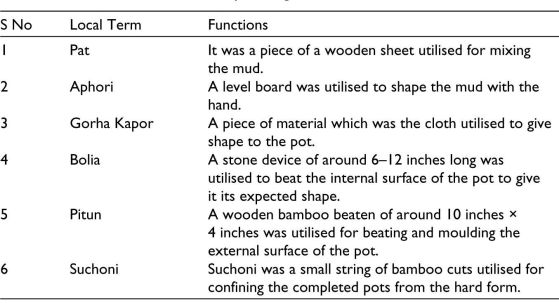
Note: Adapted from Neog (2016). Copyright 2016 by Nezine.com.
Pottery artisans were struggling to sell their wares in the market because they were using direct marketing. The barter system was followed for part of the sales and the rest by direct sales. The product market was largely local and extended to urban regions. In addition, middlemen played an important role in the marketing of these local products. They usually placed orders with the artisans and collected them for a lower cost than the market. One of the reasons for the product’s failure was to generate a desire for the product among customers directly. The production techniques were mediocre, and the products lacked standardisation.
Transportation and communication facilities were also the limiting factors on the river island of Majuli, and as a result, the rural artisans faced several challenges when attempting to sell their products in the outside market. Majuli’s pottery had suffered greatly due to the lack of better transportation and communication facilities. Bicycles, thela (hand curt) and boats were the modes of transportation and communication for these items in Majuli. These modes of transportation appeared inadequate for the smooth operation of their enterprise. The development of family-managed enterprises relied heavily on a healthy economy and the interest of the family (Kamdars & Bhuta, 2023). When it comes to pottery, the state’s dearth of basic business networks was a roadblock in the expansion and development.
Even though earthenware had domestic and foreign markets, widespread use of paper, plastic, aluminium and steel products generally posed a severe threat to pottery as a whole, and it had endured a major setback due to their resilience. The high illiteracy rate among a majority of Majuli’s potters was another challenge, which resulted in the lack of many aspects of the industry.
The pottery industry was ignored for a long time. The Indian government has launched several strategies to promote conventional small businesses, but handicrafts have stagnated due to the lack of encouragement, implementation and preparation. As a result, these manufacturing units were plagued by illness and the artisans were trapped in a vicious cycle of poverty. Recent initiatives of the government relating to the toy-making industry were an example of reviving the old forms of small family businesses, which had good market potential. The budget allocation of 15 billion USD (US dollars) in the budget of 2022 for the North-east to revive the traditional forms of living was but a welcome initiative from the government.
The family businesses, which were once thriving, are now struggling to keep up with the times. The pottery industry presents opportunities, but it also faces challenges such as lack of raw materials, labour and space for drying, firing and storing finished products. Product sales are increasing in both the national and international markets. This sector is being impacted by lifestyle changes and substitutes goods available in the market. Intermediaries earn high profits, but face challenges such as product damage, fluctuating demand and transportation issues (Shrestha, 2018). The case of the potter’s community demonstrated the struggle of small businesses owned by families to sustain their livelihoods, on the one hand, and the limited alternative sources of livelihood, on the other hand, thus, making the survival and sustenance of the family business an issue with limited solutions.
Moving Forward
Craft industries could create jobs and alleviate poverty while also fostering cultural variety and inclusivity. The sustainable livelihoods framework (Figure 7) aims to provide a comprehensive understanding of livelihoods, taking into account all of their many nuances, constraints and opportunities. These constraints or opportunities are influenced by a multitude of factors, including local norms and institution, global or national structures and trends over which people have little control or may not even be aware, and the resources that people or their households have direct access to.
Figure 7. Sustainable Livelihoods Framework.
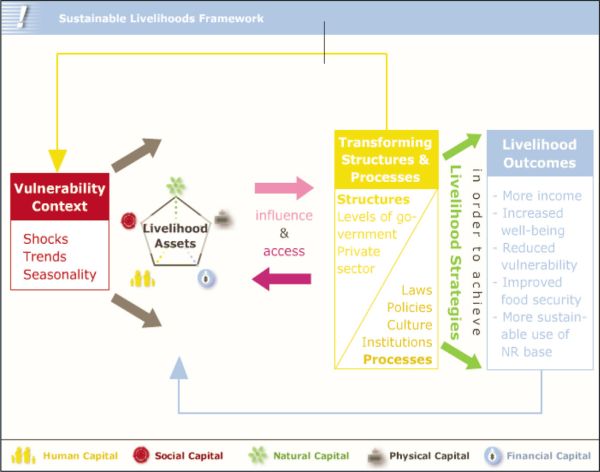
Source: DFID (2000).
The framework depicts stakeholders as operating in a context of vulnerability, within which they have access to certain assets. Assets gain weight and value through the prevailing social, institutional and organizational environment (policies, institutions and processes). This context decisively shapes the livelihood strategies that are open to people in pursuit of their self-defined beneficial livelihood outcomes. (Kollmair & Gamper, 2002)
Their vulnerability can be seen in terms of the shocks they experience because of the changing trends and alternatives available for pottery at the global and national level along with the stagnancy that they had reached in terms of their personality. This restricted their access to the structure and processes towards their transformation and alternative strategies for their livelihood, thus affecting the outcomes.
In this context, the case was built around the conflict where families underwent an environment that offered opportunities, unrelated to the skills and passion of the family businesses, on the one hand, and the experience of the families helplessly observing the dying form of the art/passion/skills, on the other hand. In summary, the conflict revolved around the question of continuing the struggle for enlivening their passion/art or giving up the art/family culture to take up a transformative route to earn a livelihood for their family.
Declaration of Conflicting Interests
The authors declared no potential conflicts of interest with respect to the research, authorship and/or publication of this article.
Funding
The authors received no financial support for the research, authorship and/or publication of this article.
ORCID iD
Dashimti Marwein  https://orcid.org/0000-0002-5678-1745
https://orcid.org/0000-0002-5678-1745
Dewani, U. (2016, September 24). Of broken pots and dreams. India Water Portal. https://www.indiawaterportal.org/articles/broken-pots-and-dreams
DFID. (2000). Sustainable livelihoods guidance sheets, Section 2. Framework.
Duary, N. (2008). Traditional Hira potters of lower Assam. Indian Journal of Traditional Knowledge, 7(1), 98–102. https://www.researchgate.net/publication/291627897_Traditional_Hira_potters_of_lower_Assam
Kamdars, P., & Bhuta, S. (2023, October 24). How family businesses in India are driving innovation and economic growth. The Economic Times. https://economictimes.indiatimes.com/news/company
Kollmair, M., & Gamper, St. (2002). The sustainable livelihood approach. Input paper for the integrated training course of NCCR north–south. Development Study Group. University of Zurich.
Neog, B. C. (2016, June 23). Majuli artisans keep ancient handmade pottery and centuries-old barter trade system alive. https://www.nezine.com/info/ZHpGMTA5az F6MGpQR3Y0dXpobU10Zz09
Rahman, A. P. (2015, December 10). Eroding Brahmaputra threatens Majuli’s unique pottery industry. The Third Pole. https://www.thethirdpole.net/en/culture/eroding-brahmaputra-threatens-majulis-unique-pottery-industry/
Shrestha, P. (2018). Challenges and scopes of pottery industry. Pravaha, 24(1), 147–158. https://doi.org/10.3126/pravaha.v24i1.20234